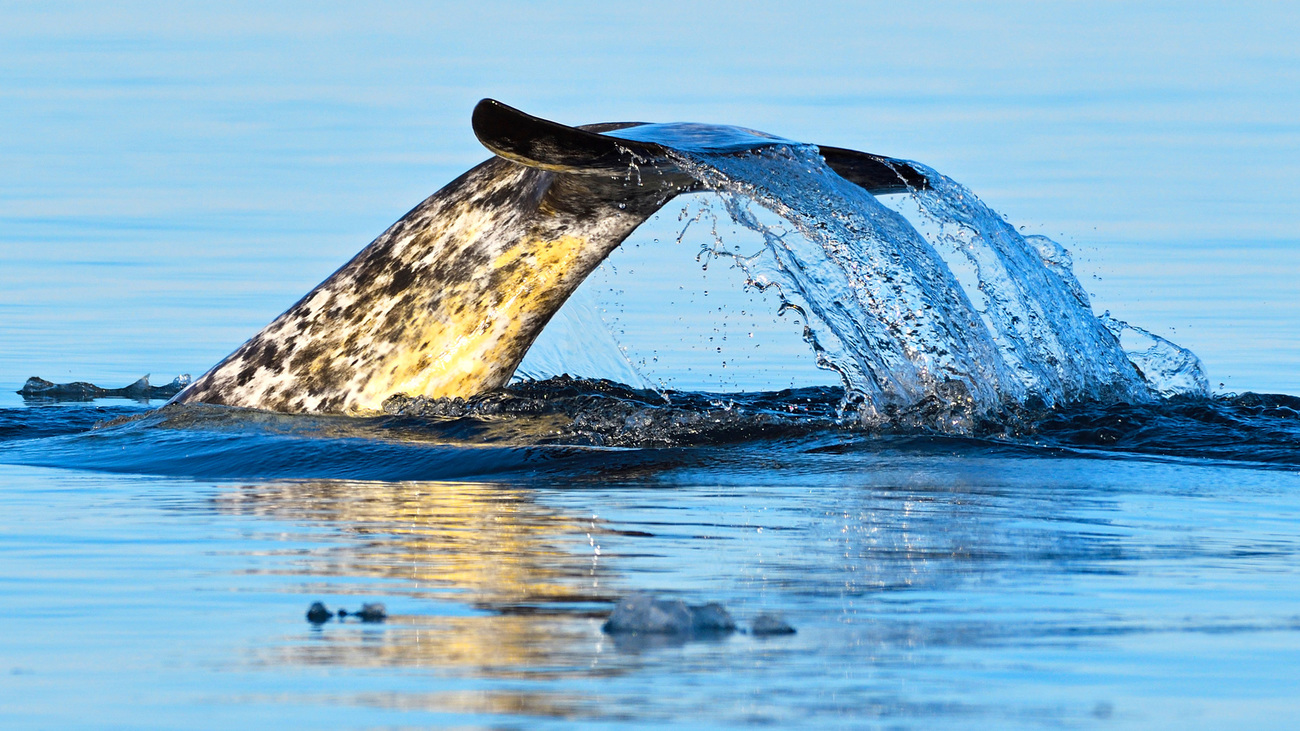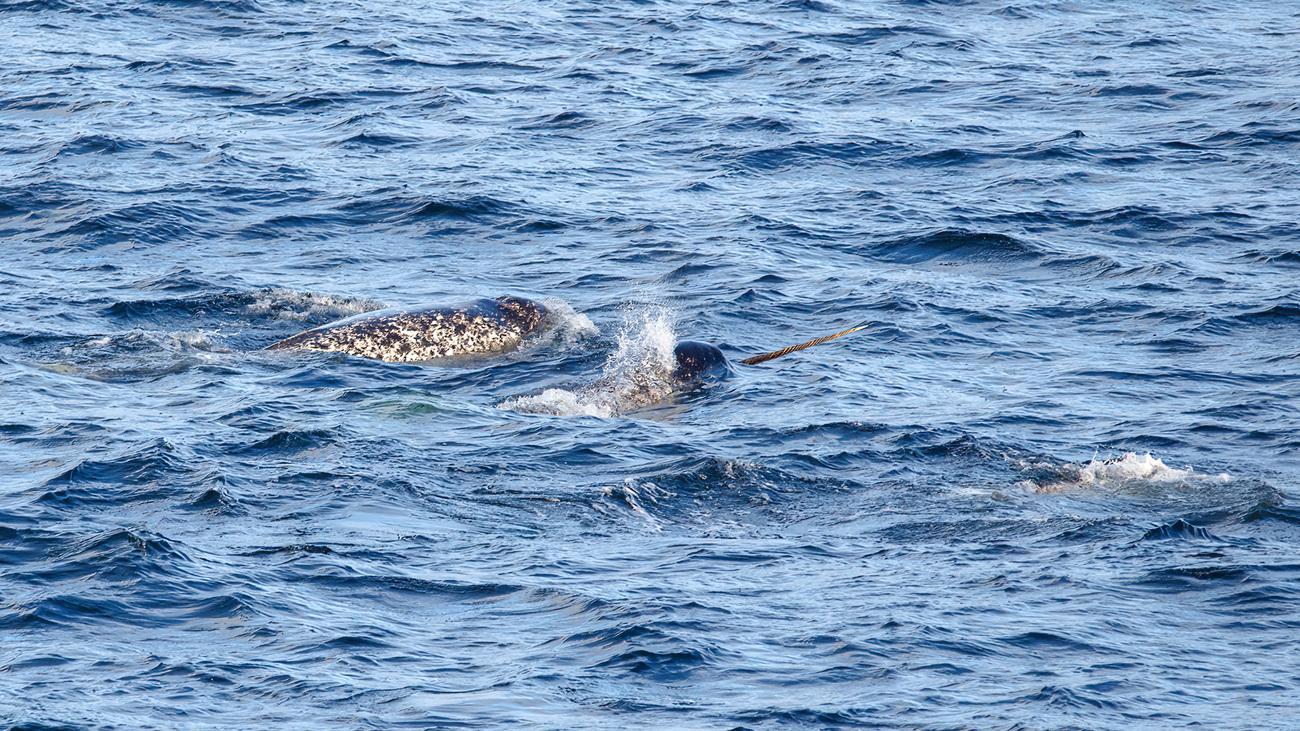Narwhals
Narwhals are small, toothed whales found along coasts and rivers in the Arctic and are famous for their single large tusk. These tusks appear primarily on males and grow continuously throughout their lives—reaching lengths of up to three and a half meters. A narwhal tusk is made out of ivory and actually begins as a tooth—one of two with which narwhals are born.
Either tooth has the potential to grow into a tusk, but the tusk is more commonly formed from the left tooth. In rare cases, males can grow two tusks. It’s also possible for females to grow a tusk, though it doesn’t happen very often, and female narwhal tusks tend to be smaller. The tusk itself grows in a spiral and is the only type of tusk known to appear completely straight.
The purpose of a narwhal’s tusk has been unclear to scientists for quite some time. Charles Darwin believed that male narwhals use their tusks to compete for female mates, and modern researchers also lean towards this theory. Because tusks are only found on male narwhals, they’re likely not used for survival purposes like hunting or eating. However, nerve endings on the tusk’s surface suggest that it has some sensory use.
In medieval times, narwhals were hunted for their tusks, and people would sell them as unicorn horns—earning narwhals the nickname ‘unicorn of the sea’.
Narwhals tend to travel in groups of 15 to 20, though larger gatherings of hundreds or even thousands of individuals have been observed. They use sound to communicate with each other, as well as to navigate their surroundings, hunt, and see.
Not much is known about the reproductive habits of narwhals, but we do know that females go through menopause and spend a significant amount of time in a post-reproductive phase. They also live for a long time, with the oldest individuals reaching up to 125 years.
Narwhals are at the top of the food chain and play an important role in the overall health of their environment. They help regulate the populations of prey species and act as a traditional source of food for indigenous communities in the Arctic.
What is a narwhal’s scientific name?
The narwhal’s scientific name is Monodon monoceros, which means “one tooth, one horn” in Latin. This refers to the fact that narwhals are born with two canine teeth, one of which (in males) grows into a horn.
Their common name may come from the Icelandic words nar, meaning corpse, and hvalr, meaning whale. Legend tells that early sailors in the Arctic thought the mottled pattern on the narwhal’s skin looked like a dead sailor in the water—leading to their name translating to corpse whale.
Are narwhals endangered?
Narwhals are not endangered. They are listed as Least Concern (LC) on the IUCN Red List, with numbers estimated at around 123,000 mature individuals. However, they were listed as Near Threatened (NT) from 2008-2017 and still face several threats that could affect their numbers in the future. These include hunting, entrapment, climate change, pollution, human activity, and noise.
Where do narwhals live?
Narwhals live in the Arctic Ocean, mostly in the Atlantic sector, but they have also been recorded in the Pacific sector. Their largest numbers live around Canada, Greenland, and eastern Russia. They usually migrate from under the ice in the winter to inshore waters in the spring and coastal waters in the summer.
Threats
Although narwhals are not endangered, several changing factors could threaten them in the near future. These are mostly related to the reduction in sea ice, which leads to increased human presence in the Arctic. Major threats to narwhals include hunting, entrapment, climate change, pollution, human activity, and noise.

Hunting
Like elephant tusks, narwhal horns are made of ivory and targeted by hunters. Ivory has long been considered a luxury item, and narwhals have been part of the trade for as long as elephants. It’s said that the British Queen Elizabeth I spent the equivalent of £1.5 million on a narwhal tusk in the late 1500s.
Learn more about the ivory trade and how IFAW works to protect elephants, narwhals, and other animals hunted for their ivory.
Narwhals are also hunted for food by small Inuit communities in northern Canada and Greenland. In Greenland, narwhal skin and blubber are considered a delicacy and are often served raw and diced in a dish called mattak.
Hunting narwhals has long been a tradition for these communities, but there is growing concern about dwindling populations. In Ittoqqortoormiit, the main narwhal hunting location in east Greenland, the narwhal population dropped from 1,900 in 2008 to around 400 in 2016. Many scientists and researchers believe hunting should reduce or stop entirely to prevent populations from dropping further.
Entrapment
Entrapment is a natural phenomenon that happens to narwhals and other marine animals in the Arctic. It’s caused by sudden breaks and movements in sea ice that close off the openings narwhals use to come up for air. However, scientists have recorded an unexpected increase in entrapments in the last 20 years, which could be due to temperature shifts.
Climate change
The Arctic is highly sensitive to temperature change, and recent warming trends negatively impact narwhals. The reduction of sea ice creates several problems and potential future threats, including entrapment and reduced food availability from affected prey species. Higher temperatures could also result in new species entering the areas where narwhals usually live and increasing competition for resources.

Pollution
Researchers can record changes in the amount of environmental contaminants like mercury by studying narwhal tusks. They can track mercury levels in each layer of the tusk. Mercury pollution is most dangerous for top predators, like narwhals, who ingest the largest amounts.
Research shows that narwhals’ mercury levels have significantly increased since around 2000. The impact of high mercury levels in narwhals isn’t completely understood, but it’s feared that it could affect cognitive and reproductive abilities.
Human activity and noise
Narwhals are especially sensitive to noise and use sound to see, hear, communicate, and navigate. This means disruptive ocean noise greatly affects narwhals and can harm their ability to find food, find each other, and find where they need to go. Human activity, from exploratory boats to seismic air guns, creates more damaging noise in the Arctic areas narwhals call home.
Learn more about IFAW’s efforts to reduce ocean noise.
FAQs

Are narwhals real?
Although narwhals are sometimes called the ‘unicorns of the sea’, they are indeed real—and some even have two horns. They exist in large numbers in different parts of the Arctic Ocean, and it’s common to see them in the wild.
What is a narwhal?
A narwhal is a marine mammal in the ‘toothed whale’ group, otherwise known as an odontocete. They have a black, grey, and white mottled pattern on their skin with a white underbelly. Males (and a few females) also have a large horn protruding from their top lip. Because narwhals live in the Arctic under the sea ice, they have been difficult for humans to study, and we don’t know a lot about their lifestyle and reproduction.
What do narwhals eat?
Narwhals have a seasonal diet, eating the most during the winter and feeding much less during the summer when the ice has melted. Their primary prey is Greenland halibut, polar and Arctic cod, shrimp, and Gonatus squid. They usually hunt their food on the ocean floor and use their mouths to create suction that catches their prey.
Where do narwhals live?
Narwhals live exclusively in the Arctic Ocean, where they spend much of their time underneath the sea ice. They’re mostly found around northeastern Canada, northern and eastern Greenland, Svalbard, and northern Russia.
Are narwhals extinct?
No, narwhals are far from extinct. They’re currently listed as Least Concern (LC) on the IUCN Red List, though they were considered Near Threatened (NT) until 2017.

Why do narwhals have horns?
Although the narwhal’s horn is the reason for its worldwide fame, there’s a lot we don’t know about it, including its purpose. Some theories say it’s a sensory organ because it has millions of tiny holes and nerve endings on the surface. Others believe the tusk is used for social reasons like impressing females and earning a partner. A recent study found that the largest male narwhals had disproportionately long tusks—possibly signalling a connection between sexual dominance and tusks. Because only a few female narwhals grow tusks, they likely aren’t used for hunting or eating.
How many narwhals are left?
According to the IUCN, narwhals have a population of around 123,000 mature individuals living in approximately 12 subpopulations around the Arctic.
Is a narwhal a whale?
Yes, narwhals are a type of toothed whale and are related to beluga whales. However, they are different from other toothed whales, such as dolphins, porpoises, and sperm whales, because they don’t have a full set of teeth. Instead, they grow just two teeth, one of which spirals upwards from their lip and can become a tusk.
Are narwhals dangerous?
Narwhals aren’t likely to be aggressive towards humans. However, humans present a danger to narwhals. Until recently, narwhals have been highly segregated from human activity due to their Arctic habitats. However, as the sea ice melts, it opens up the Arctic for hunting and shipping. This increases interactions between humans and narwhals and also leads to bycatching.
According to research, the shock of being caught in a fishing net triggers a dangerous reaction in narwhals. When animals face a threatening situation, they typically choose to either freeze or flee. Freezing involves a drastic lowering of the heartbeat while fleeing speeds it up.
Unfortunately, scientists have observed narwhals displaying a paradoxical combination of both freezing and fleeing. When caught in nets, they appear to freeze up and lower their heartbeats to an extremely low three to four beats per minute. At the same time, they break free from the net and flee at top speeds, somehow maintaining a low heart rate even after swimming for a significant period of time. The consequences of this reaction aren’t yet known, but scientists fear it puts a massive strain on the narwhals’ hearts and could even result in sudden death.
Do all narwhals have horns?
Male narwhals are more likely to grow a horn or tusk. They have two canine teeth that can grow into tusks by spiralling upwards and exiting through the upper lip. Usually, the left tooth grows into a tusk. However, in one out of 500 cases, both canine teeth grow, and males end up with two tusks. Female narwhals also occasionally grow tusks, although this only happens in about 15% of females.
How can you help?
Although narwhals are not endangered, several changing factors could threaten them in the near future, including ocean noise, hunting, entrapment and climate change.